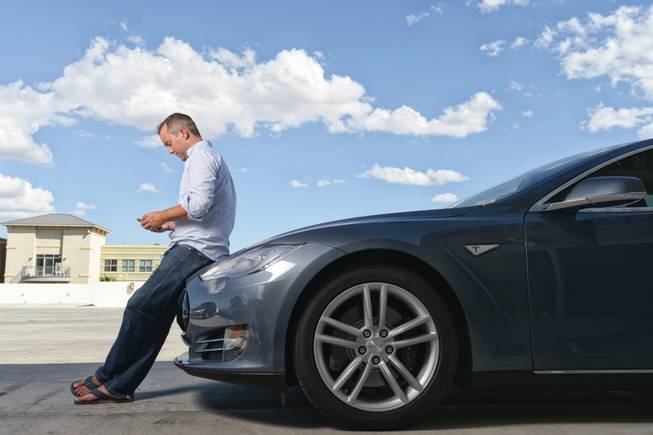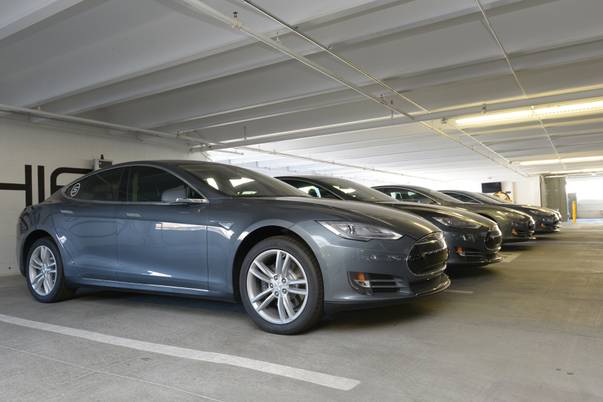
Spencer Burton
Shift CEO Zach Ware says the startup’s Tesla order actually undermined his goal of bringing car-sharing to downtown Las Vegas.
Tuesday, July 21, 2015 | 2 a.m.
In 2013, downtown Las Vegas car-sharing company SHIFT made news for placing the largest U.S. order in Tesla history: 100 Model S luxury sedans.
The plan was to innovate transportation downtown, through a web of shared vehicles: Smart cars, Chevy Volts, bicycles and, most notably, the Tesla order, which was covered by media ranging from the Las Vegas Weekly to TechCrunch. The network would coincide with the goals of Shift’s investor, Zappos CEO Tony Hsieh, who was attempting to revitalize the area through a $350 million investment.
Earlier this year, SHIFT closed up shop, leaving one, glaring question: What happened to all those Teslas?
A PandoDaily story published earlier this month reported the 100 Teslas were never delivered. But last year, SHIFT released a widely-circulated photo of Teslas in a downtown parking lot. So what happened?
According to Shift CEO Zach Ware, the company actually did receive one delivery of Teslas. The plan had always been to receive the cars in stages, Ware said. The first wave, of 10 to 20 Teslas, arrived in June of last year.
“As our strategy evolved and ultimately led to the wind down of the company ... we canceled the remaining vehicles on our [Tesla] order,” Ware wrote in an email.
Ware said the Teslas that had already been delivered were sold to a variety of buyers.
Expectations versus reality
Shift set itself a bold goal: Bring car-sharing to downtown Las Vegas — and make the face of the project Teslas, a much higher-end car than those utilized in other cities with similar programs.
Somewhere along the way, the prospect of 100 Teslas came to overshadow the company’s larger mission and became its only external yardstick for success, Ware said.
“The lesson I learned as a founder was to focus first on developing a product that people will love and let the press coverage follow,” Ware said in the email. “Because the Tesla story was so large, it's what everyone in the media measured our success by.”
Raising expectations that there would be 100 Teslas, Ware said, undermined the company’s ability to highlight other, just as important, successes, such as a 24/7 booking system it designed and sophisticated in-car control systems.
“It got us a lot of press and it was very intoxicating,” Ware said in a follow-up phone interview. “When you put entire playbook on table, you definitely have to work toward that playbook.”
Downtown ties
The closure of Shift, which at one point appeared to be one of downtown’s most promising — and practical — startups, has been considered by many, including the 7,000-word PandoDaily story, as another failure in a long line of now-defunct downtown ventures. (The most famous of those is Factorli, a manufacturing company lauded by President Barack Obama just months before ceasing operations late last summer.)
Ware says Shift was not affiliated with the Downtown Project and that Hsieh made a personal investment in Shift separate from the $350 million he invested in the Downtown Project.
But the line between Shift and the Downtown Project starts to blur when you consider how Hsieh described the two.
In a memo last fall, Hsieh described the Downtown Project as a collection of entities and included Shift as an example of a business in which DTP was an investor or co-owner.
With the $350 million investment now disbursed in real estate, businesses and a tech fund, it’s often hard to tease out where the Downtown Project’s influence begins and ends. Part of this stems from the high expectations that come with attempting to revitalize an entire downtown.
Mark Rowland, CEO of Downtown Project Ventures, DTP’s investment arm, conceded in a recent interview with KNPR that some expectations were probably too optimistic. The initial buzz around DTP cut both ways because, similar to what happened with Shift, it generated the excitement necessary to launch the project while also forcing DTP to deliver on a number of splashy goals.
“To think that it would be done in three years was probably wishful thinking,” Rowland said. “But certainly, I’ve got no issue with people having that as a goal and seeing what happens when you actually charge people with that task. I think if you just said, ‘This is a 20-year project,’ you might not have seen a lot of the activity and endeavor that actually went into the first three years of the Downtown Project.”



Join the Discussion:
Check this out for a full explanation of our conversion to the LiveFyre commenting system and instructions on how to sign up for an account.
Full comments policy